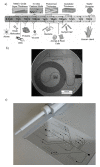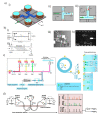A Critical Review on the Sensing, Control, and Manipulation of Single Molecules on Optofluidic Devices
- PMID: 35744582
- PMCID: PMC9229244
- DOI: 10.3390/mi13060968
A Critical Review on the Sensing, Control, and Manipulation of Single Molecules on Optofluidic Devices
Abstract
Single-molecule techniques have shifted the paradigm of biological measurements from ensemble measurements to probing individual molecules and propelled a rapid revolution in related fields. Compared to ensemble measurements of biomolecules, single-molecule techniques provide a breadth of information with a high spatial and temporal resolution at the molecular level. Usually, optical and electrical methods are two commonly employed methods for probing single molecules, and some platforms even offer the integration of these two methods such as optofluidics. The recent spark in technological advancement and the tremendous leap in fabrication techniques, microfluidics, and integrated optofluidics are paving the way toward low cost, chip-scale, portable, and point-of-care diagnostic and single-molecule analysis tools. This review provides the fundamentals and overview of commonly employed single-molecule methods including optical methods, electrical methods, force-based methods, combinatorial integrated methods, etc. In most single-molecule experiments, the ability to manipulate and exercise precise control over individual molecules plays a vital role, which sometimes defines the capabilities and limits of the operation. This review discusses different manipulation techniques including sorting and trapping individual particles. An insight into the control of single molecules is provided that mainly discusses the recent development of electrical control over single molecules. Overall, this review is designed to provide the fundamentals and recent advancements in different single-molecule techniques and their applications, with a special focus on the detection, manipulation, and control of single molecules on chip-scale devices.
Keywords: fluorescence; lab-on-a-chip; microfluidics; nanopore; optofluidics; single-molecule method.
Conflict of interest statement
The authors declare no conflict of interest.
Figures








Similar articles
-
Recent Advancements in Nanophotonics for Optofluidics.Adv Phys X. 2024;9(1):2416178. doi: 10.1080/23746149.2024.2416178. Epub 2024 Oct 22. Adv Phys X. 2024. PMID: 39554474
-
Recent advances in integrated solid-state nanopore sensors.Lab Chip. 2021 Aug 21;21(16):3030-3052. doi: 10.1039/d1lc00294e. Epub 2021 Jun 17. Lab Chip. 2021. PMID: 34137407 Free PMC article. Review.
-
Recent advancements in optofluidics-based single-cell analysis: optical on-chip cellular manipulation, treatment, and property detection.Lab Chip. 2014 Apr 7;14(7):1230-45. doi: 10.1039/c3lc51211h. Lab Chip. 2014. PMID: 24525555 Review.
-
Optofluidic bioanalysis: fundamentals and applications.Nanophotonics. 2017 Jul;6(4):647-661. doi: 10.1515/nanoph-2016-0156. Epub 2017 Mar 16. Nanophotonics. 2017. PMID: 29201591 Free PMC article.
-
Optofluidic integration for microanalysis.Microfluid Nanofluidics. 2008;4(1):53-79. doi: 10.1007/s10404-007-0223-y. Epub 2007 Sep 11. Microfluid Nanofluidics. 2008. PMID: 32214954 Free PMC article.
Cited by
-
All-in-One Optofluidic Chip for Molecular Biosensing Assays.Biosensors (Basel). 2022 Jul 9;12(7):501. doi: 10.3390/bios12070501. Biosensors (Basel). 2022. PMID: 35884304 Free PMC article.
-
Orthogonal CRISPR/Cas system facilitated dual-color fluorescence fiber-embedded optofluidic nano-biochip for parallel amplification-free on-site detection of bacterium and virus.Mikrochim Acta. 2025 Jun 12;192(7):417. doi: 10.1007/s00604-025-07289-5. Mikrochim Acta. 2025. PMID: 40500518
-
Microrobots in Micromachines.Micromachines (Basel). 2022 Jul 29;13(8):1207. doi: 10.3390/mi13081207. Micromachines (Basel). 2022. PMID: 36014128 Free PMC article.
-
Microfluidics as a promising technology for personalized medicine.Bioimpacts. 2024 Jun 16;15:29944. doi: 10.34172/bi.29944. eCollection 2025. Bioimpacts. 2024. PMID: 39963565 Free PMC article. Review.
References
Publication types
LinkOut - more resources
Full Text Sources
Other Literature Sources
Miscellaneous

